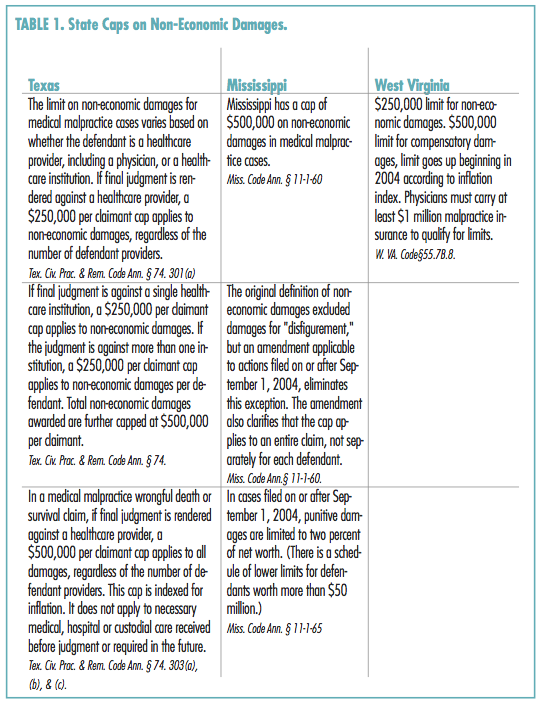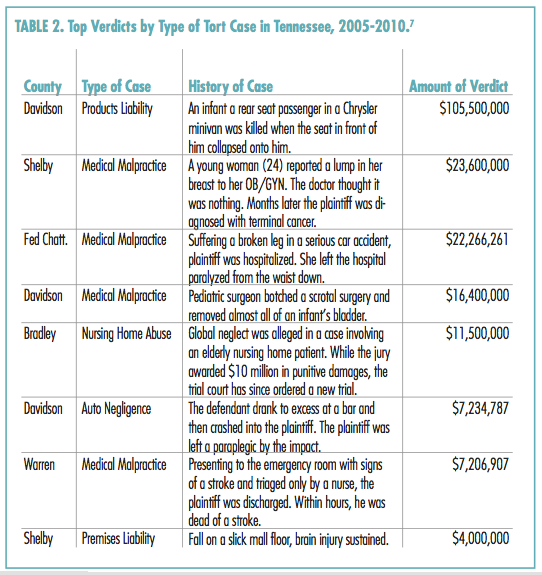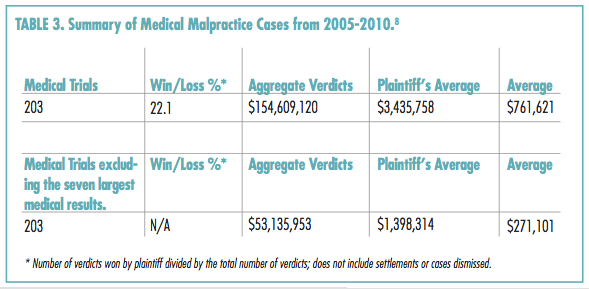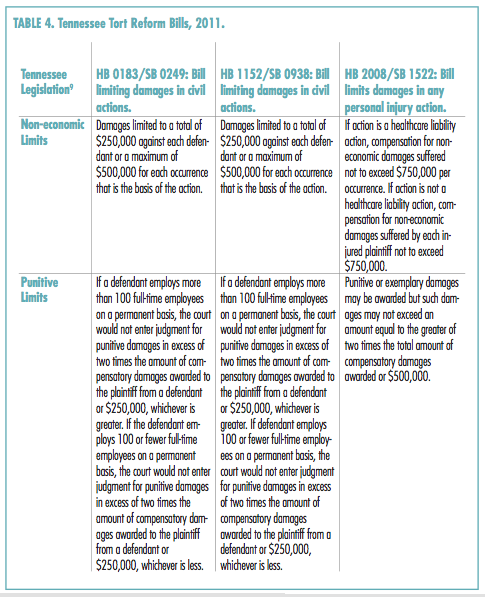27 Jul Tort Reform: Background and Case Studies
A tort is a private civil wrong or injury for which the law provides a remedy in the form of money damages. Tort suits consist of such actions as medical negligence, personal injury, bad faith and products liability claims. If the negligence or wrongful conduct of another party can be proven, the injured party may be entitled to monetary compensation from that party in the form of economic and non-economic damages. Economic damages compensate a victim for more easily quantifiable financial losses such as medical bills, lost wages, loss of household services and future medical expenses. Non-economic damages are damages awarded for injuries such as pain, suffering, loss of enjoyment of life, disfigurement and loss of consortium (affection and services of spouse, parent or child). These types of economic and non-economic damages are called compensatory damages and are intended to compensate an injured person for his losses. Punitive damages are another type of damages. Their two-fold purpose is to punish wrongful conduct and to deter others from engaging in similar conduct in the future. Punitive damages have been awarded by Tennessee’s courts for over 100 years. To recover punitive damages, an injured party must typically prove that a defendant intended to cause harm, or acted recklessly, fraudulently or maliciously. While punitive damages have not become commonplace in Tennessee, they have become prevalent in specific types of tort cases. They are more frequently awarded in the nursing home industry where claims of elderly abuse and reckless practices have been alleged, and in the trucking industry when drivers have a criminal record, a poor driving record, drug abuse histories or the company has followed reckless maintenance practices.
EXISTING TORT LAW
Tort reform has been enacted in various forms in a number of states. While an exhaustive review of the various forms is beyond the scope of this article, a brief review of tort reform in a few states serves as a reference for comparison with the tort reform bills proposed for Tennessee. Most tort legislation seeks to control non-economic and punitive damages. Some states focus on limiting damages in only certain types of tort cases; other states apply limits broadly to all types of tort claims. Mississippi, West Virginia and Texas have established laws that limit the amount of non-economic damages a plaintiff can receive. They are summarized in Table 1.
The Tennessee General Assembly is now considering placing caps on non-economic damages and punitive damages in all types of tort cases. Limits on damages recoverable in tort actions are not an entirely new phenomenon in Tennessee. As part of the Medical Malpractice Act of 1975, the legislature prohibited injured parties from stating to the jury a specific amount of money sought for non-economic damages in a medical mal- practice action. Additionally, medical expenses recoverable in medical malpractice cases were limited by Tenn. Code Ann. § 29- 26-119. This statute prohibits plaintiffs from recovering as damages medical expenses paid by health insurance or other third-party payor, unless the plaintiff actually paid premiums for the health insurance or the third-party payor held a right of subrogation for recovery of those expenses. In any event, a plaintiff is only permitted to recover the amount of medical expenses actually paid, rather than the amount of charges incurred. Thus, if medical expenses of $50,000 were charged to treat a surgical complication resulting from negligence but the actual payment of those expenses was only $12,000, then a plaintiff could only recover $12,000, assuming the plaintiff paid the health insurance premiums or a right of subrogation existed. In non-medical malpractice tort cases, a plaintiff can recover the total amount of the charges for medical treatment regardless of whether the plaintiff paid the health insurance premium and regardless of whether there is a right of subrogation.

Prior to 1999, plaintiffs in Tennessee were also limited in the amount of damages they could receive in wrongful death tort cases. At that time under Tennessee law, plaintiffs could recover economic damages and pain and suffering damages in a wrongful death case, but could not recover damages for loss of consortium. In effect, this was a type of cap on non-economic damages in wrongful death cases because loss of consortium damages typically would be the type with the greatest monetary value. However, in the 1999 case of Jordan v. Baptist Three Rivers Hospital (984 S.W.2d 593(Tenn. 1999)), the Tennessee Supreme Court overruled precedent and determined that damages in a wrongful death case could include monetary damages for the loss of the deceased’s love, affection and consortium. This led to larger verdicts and made wrongful death cases without significant economic damages now profitable for attorneys to prosecute. Some proponents of tort reform point to large verdicts rendered since the Jordan decision as evidence of the need for tort reform in Tennessee (Table 2). Notably, many of the largest verdicts are reduced by appellate courts or settled for lesser amounts while appeals are pending. Statistics show that although verdicts are larger in medical malpractice cases, they still remain infrequent. These numbers may also reflect the fact that large verdicts have tended to scare physicians into resolving cases merely due to the fear of facing a verdict exceeding their insurance coverage, rather than evaluation of the merits of the claims.
In Tennessee from 2005-2010, seven of the medical plaintiffs- 3.4 percent of all those went to trial- received 65.6 percent of the awards. By contrast, the other 96.6 percent of plaintiffs in these cases took 34.4 percent of the awards (Table 3).
TORT LEGISLATION
Several tort reform bills are pending in the Tennessee legislature this session (Table 4). These bills are likely to be changed in any number of ways before ultimately being enacted. They apply to all tort cases and impose sum certain limitations on specific types of damages. At the time of publication, HB 2008/SB 1522 appeared to be getting the most legislative attention.
Proponents of these tort reform bills argue that caps on damages will lead to a fairer, more just system and boost the state economy. They maintain that the size and frequency of large jury awards and settlements in medical malpractice cases is behind the rapid increase in malpractice insurance premiums and the rising costs of healthcare. It is not necessarily large verdicts in tort cases that drive up healthcare costs, but proponents argue that physicians are required to practice defensive medicine to protect themselves from future possible lawsuits, therefore leading to additional tests that may not be clinically indicated. They also maintain that high malpractice rates are driving physicians out of business or prompting them to move to states which have law capping malpractice awards. In general, proponents assert that awards are becoming excessive, citing Ernst v. Merck (No. Civ.A.H-02-3490, 2002 WL 34433652 (S.D. Tex. Oct 23, 2002)). In Ernst v. Merck, a Texas Vioxx products liability case, the jury issued a verdict of $24 million in non-economic damages for a widow of a 59-year-old triathlete who died from arrhythmia, which the plaintiff alleged could have been prevented had Merck provided warnings about the drug. Tort reform supporters criticized the award as excessive because the widow had not been married to the descendent very long.
Opponents argue that caps will harm those patients who suffer the most damage and who need help the most, and that payments for medical malpractice claims are not the underlying cause of rapidly increasing malpractice premiums or higher healthcare costs. They also argue that under our legal system, the amount of damages should be determined by a jury of peers not by the government.
Texas, Mississippi and West Virginia have stated that the effects from caps on non-economic damages have led to the following positive development in their states:
-Reduced medical malpractice liability insurance premiums for physicians;
-Increased physician recruitment and retention; and
-An increase in the number of businesses coming into the state
On the other hand, critics point to several studies conducted after California enacted its 1975 law limiting non-economic damages. These studies found the following negative impacts on injured persons:
-The most severely injured patients had the greatest reduction in damage awards;
-Verdicts for injuries such as deafness, numbness, disfigurement and chronic pain which do not impair physical functioning or cause wage loss or high healthcare costs were virtually wiped out by the cap; and
-Women and elderly individuals suffered the most significant disparate impact from the caps because they typically have the lowest value economic damages.
To illustrate the effect of caps on plaintiff’s awards, listed below are some examples of monetary damage awards under the proposed legislation HB 2008/SB 1522.
EXAMPLE 1
Ms. X is a 40-year-old housewife with no college education. After marrying she decided not to pursue further education or a career but to stay at home and raise a family. Ms. X was prescribed a new medication for upper respirator infections. After several doses, she developed a severe side effect from the medication that had been recognized during clinical trials. This disorder caused a scalding like condition to her skin that resulted in her hospitalization. She remained in significant pain, eventually succumbing to the complications from the disorder within two weeks of her diagnosis and admission to the hospital. Her children, six and eight years of age, who also witnessed their mother’s condition, have been diagnosed with post-traumatic stress disorder and are unable to sleep or function well at school since her death. The family has sued the drug manufacturer for placing a defective and dangerous product on the market without sufficient clinical trials and has sued the physicians who prescribed the medication for prescribing it without attempting alternative treatments first.
Damages claimed are:
-Economic losses: 1) medical bills of $90,000 related to her two-week hospitalization for this injury; 2) loss of earning capacity of $485,000 if she returned to work through her work life expectancy; and 3) value of loss of household services $325,000.
-Non-economic losses: 1) children’s and husband’s claims for loss of consortium and any emotional injury; and 2) Mrs. X’s claims for pain and suffering and disfigurement before her death.

Assuming Mrs. X prevailed at trial, there is no damage limit under existing laws. Loss of consortium damages of about $1 million for the spouse and each child have been awarded in these types of cases. Thus, a verdict in the range of $4 million is a reasonable possibility.
Under the proposed legislation, the maximum damage award would be $1.65 million. The non-economic losses (claims of the patient, husband and children for pain and suffering, loss of consortium, loss of enjoyment of life, disfigurement, negligent infliction of emotional distress, etc.) are capped at $750,000. Although there are two defendants (drug manufacturer and physician), this action would be a healthcare liability action and the camp of a single limit per occurrence would apply. The damages for economic losses (medical bills, loss of earning capacity, and loss of household services) total $900,000 and are not capped. Notably, if this case was not a healthcare liability action and the deceased had been killed by a driver, then the maximum damage award would be $3 million – each plaintiff would be permitted a recovery of $750,000.
EXAMPLE 2
Mr. Y is 64 years of age. He recently retired from a factory blue-collar position because decreased mobility prevented him from performing the physical demands of the job. Mobility limitations preclude him from meaningful work, although he has no serious health concerns affecting his life expectancy. He and his wife of 40 years live alone in Nashville, TN. They have several children and grandchildren who live out of state. After saving for 20 years, they have purchased a small motor home and plan to spend the next several years traveling and enjoying their golden years together. Mr. Y was involved in a car accident when the other driver ran a red light. The other driver is a wealthy businesswoman known in the community and listed in business magazines as one of the wealthiest individuals in the United States. She ran the red light because she was driving under the influence after having been served an excessive number of drinks by a bartender at an exclusive private country club. Mr. Y suffered serious injuries and died in the emergency room from complications of the accident injuries. Mrs. Y has suffered from depression as a result of the loss of her husband of 40 years and their retirement dream. Mrs. Y sued the negligent driver and the country club for wrongful death, seeking compensatory and punitive damages.
Damages claimed are:
• Economic losses: medical bills of $5,000 for EMS transport and ER treatment. No significant damages can be shown for loss of earning capacity due to the deceased’s retirement, age, and limited physical capacity for work.
• Non-economic losses: 1) Mrs. Y’s claim for loss of consortium and emotional injury; and 2) claims for pain and suffering of Mr. Y.
Assuming Mrs. Y prevailed at trial, there is no limit under existing law. Several factors will motivate a jury to give a large award: 1) the emotional component of the lost retirement dream; 2) the drunkenness and wealth of the driver; and 3) one defendant is an exclusive country club with significant assets, insurance, and wealthy members. These types of facts typically anger a jury and often result in verdicts of compensatory damages alone in the tens of millions of dollars or more.
Under the proposed legislation, the maximum damage award for compensatory damages would be $1,505,000 ($750,000 x two defendants plus $5,000 in economic damages). Notably, most tort lawyers charge a contingency fee equal to one-third of the total damage award plus expenses. Thus, Mrs. Y’s net recovery would be approximately $950,000 after deduction of attorneys’ fees of $499,950 and typical litigation expenses. Punitive damages, if proven and awarded, would not exceed $500,000. For comparison, under the other two proposed bills, HB 0183/SB 0249 and HB 1152/SB 0938, the maximum damage award would be limited to $505,000 ($250,000 for each defendant plus $5,000 in economic damages). If there were only one defendant, the damages would be capped at $255,000.

EXAMPLE 3
Mr. Z is a 52-year-old electrical engineer and businessman in Nashville, TN. For the past 20 years, the manufacturing company he owns has continued to expand its product line and customer base in spite of for- eign competition. Industry analysts project continued growth and success due to Mr. Z’s innovation and ability to create unique, patent protected product lines. Unfortunately, his success and lifestyle have led to poor cardiac health. During a multiple artery stenting procedure, he experiences a perforation of the aorta and is rushed to surgery; he dies in surgery when grafting attempts fail. He is married and has four minor children. Mrs. Y sues the cardiologist performing the stenting procedure and the surgeon performing the bypass procedure. The case is tried before a jury, and the jury apportions fault – 70 percent to the cardiologist and 30 percent to the bypass surgeon.
Damages claimed are:
• Economic losses: 1) medical bills of $115,000 for the stenting procedure and bypass surgery; and 2) Mr. Z’s projected loss of earning capacity of $6 million.
• Non-economic losses: 1) Mr. Z’s claims for pain and suffering; and 2) Mrs. Z’s and the children’s claim for loss of consortium and any emotional injuries resulting from Mr. Z’s death.
Under existing law, there is no limit. Under the proposed legislation, the maximum damage award would be $6,865,000. Due to the apportionment of fault between the cardiologist and bypass surgeon, the cardiologist would be responsible for 70 percent of the verdict, or $4,805,500. The bypass surgeon would be responsible for 30 percent of the verdict, which equals $2,059,500. These damages remain significant in spite of the caps. Notably, juries appear to award less money to wealthy individuals in spite of proof of loss.
These examples illustrate that damage awards can vary broadly, based on factors not inherently related to the damages. For example, a loss can be significantly impacted by whether the defendant is a healthcare provider and the number of defendants involved. They also illustrate that large verdicts may still result when the value of economic damages, such as loss of earning capacity, loss of household services and medical expenses, is high.
If caps of any form are enacted, the landscape of tort litigation will change. Defendants in some cases will not feel pressured to settle claims solely to avoid the risk of financial ruin. On the other hand, some claims may no longer be economically viable for personal injury attorneys to pursue. However, the legal profession has historically tended to adapt to changes in the law. Their first response will most likely be a challenge to the constitutionality of any tort reform legislation enacted. However, before loss of consortium damages were recoverable in wrongful death cases, injured parties frequently hired economists to quantify damages for loss of earning capacity and loss of household services to increase the range of damages recoverable. When Jordanmade consortium damages recoverable, attorneys representing injured parties dispensed with the economists and appealed to the emotions of jurors to maximize newly recoverable consortium damages. If caps are imposed, plaintiffs are likely to return to economists to increase the amount of uncapped economic damages recoverable as in the pre-Jordan days. Greater amounts of economic damages will tend to raise verdicts to compensate for the limits imposed on non-economic damages by the caps.

As another form of adaptation, plaintiffs may also resort to new and novel nontort causes of action in an attempt to circumvent the caps. For example, a cause of action under the Tennessee Consumer Protection Act has been allowed against a physician arising out of a surgery. The Tennessee Consumer Protection Act (TCPA) allows recovery of treble damages and attorneys’ fees, which are not typically recoverable in tort actions. Because the TCPA allows treble damages, it would specifically conflict with the reform legislation capping punitive damages at two times the compensatory damages. Although a TCPA claim would appear to be a type of tort action because it is based on conduct such as fraud, it is not clear whether a court would interpret any of the recently introduced tort reform bills to supersede the specific causes of action and damage remedies of the TCPA. Thus, the Tennessee Supreme Court’s interpretation of any tort reform legislation enacted will impact its effectiveness.
Although the pending legislation contains notable differences, enactment of tort reform in Tennessee will most likely eliminate the staggering few verdicts of tens or hundreds of millions of dollars. However, total damage awards are still likely to fall into the range of $1 to $3 million in many cases. Although the threat of financial ruin may be decreased through tort reform, practitioners and businesses will want to maintain insurance coverage or reserves commensurate with their exposures under any tort reform legislation.
References:
1. Workers’ Compensation claims are not included although a type of tort. Workers’ Compensation claims have long been subject to a type of cap determined through a formula based upon the body part injured, the degree of physical and vocational impairment resulting from the injury,
and the worker’s average weekly wage at the time of the injury.
2. Owen J, Hines W, Milojevich A, Poole J: Lawsuit Abuse Reform in the Volunteer State, Policy Report. Tennessee Center for Policy Research, No. 11-02, Feb 21, 2011. Available at http://www.tennesseepolicy.org.
3. Hodges v.Toof, 833.S.W.2d 896 (Tenn. 1992).
4. Tenn. Code Ann. § 29-26-117 and Guess v. Maury, 726 S.W. 2d 906 (Tenn. Ct. App 1986).
5. Fye v. Kennedy, 991 S.W.2d 754 (Tenn. Ct. App. 1998).
6. Davidson v. Severson, 72 S.W. 967 (Tenn. 1903).
7. Tennessee Jury Verdict Reporter Year in Review (Tennessee Jury Verdict Reporter ed., 6thedition 2001).
8. Tennessee Jury Verdict Reporter Year in Review January 2011, 6thedition, TJVR, Louisville, KY, 2001.
9. Tennessee General Assembly, 2011. Bill summaries available by bill number at http://wapp.capitol.tn.gov/apps/billsearch/BillSearch.aspx.
9. Sisk C: Haslam proposes no cap on charters, longer wait for teacher tenure. The Tennessean, Feb 17, 2011. Available at http://www.wbir.com/news/article/157493/2/Haslam-proposes-no-cap-on-char….
10. Thompson F: Tennessee Justice System ‘Ain’t Broke.’ Knoxville News Sentinel, Jan 29, 2011. Available at http://www.knoxnews.com/news/2011/jan/29/tennessee-justice-system-aint-b….
11. American Tort Reform Association: How Tort Reform Works, 2007. Available at http:/www.atra.org.
12. Studdert DM, Yang YT, Mello MM: Are Damage Caps Regressive? A Study of Malpractice Jury Verdict in California. The Harvard School of Public Health. Hlth Aff (23)4:54-67, Jul 2004. Pace NM, Golinelli D, Zakaras L: Capping Non- Economic Awards in Medical Malpractice Trials,
California Jury Verdicts Under MICRA. Prepared for the Rand Institute of Civil Justice, Jul 2004. Finley LM: The Hidden Victims of Tort Reform: Women, Children and the Elderly. Paper deliv- ered to Thrower Symposium, Emory Law School, Feb 19, 2004.
13. The legislation is unclear as to whether a sepa- rate cap applies to the deceased’s claim for pain and suffering. The Tennessee Supreme Court has characterized a wrongful death claim in Tennessee as a single right of action. However, the Court has interpreted that single right of action to include non-economic damages for the decedent as well as the survivors. Consequently, the Court would most likely interpret the legislation to allow one recovery for the decedent up to $750,000 for non-economic damages of the decedent and separate recoveries of up to $750,000 for each survivor.
14. Proctor v. Chattanooga Orthopaedic Group, 270 S.W. 3d 56, (Tenn. Ct App. 2008). Dr. Regan is an associate with North Pursell & Ramos, PLC, in Nashville; Mr. Hadley is a partner with NPR, with a practice that includes defending physicians in malpractice and licensure actions.
Dr. Regan is an associate with North Pursell & Ramos, PLC, in Nashville; Mr. Hadley is a partner with NPR, with a practice that includes defending physicians in malpractice and licensure actions.


